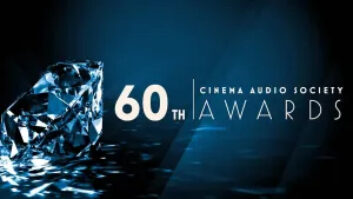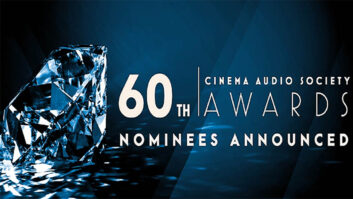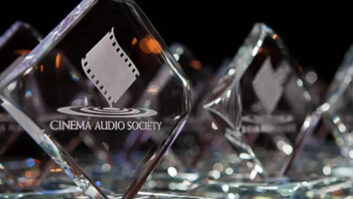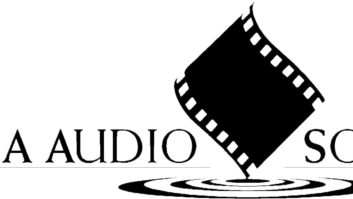In our sometimes over-inflated, over-hyped technological world, where audio addicts frenzy over the latest, the greatest, the oldest and the coolest, Chris Fogel is a refreshing breath of fresh air. The emperor better not try wearing any new clothes around this guy: A brisk engineer who works with streamlined gear, Fogel espouses a totally no-nonsense approach to his art.
The results of his engineering style are the proof; it was Fogel’s mixes that scorched the airwaves during the summer of ’95 on Alanis Morissette’s Jagged Little Pill. He’s continued to work with Morissette on almost all of her music, including her current smash, Under Rug Swept, as well as with U2, Seal, the late Aaliyah, Sheryl Crow, John Hiatt and Robbie Robertson, among others, garnering a Grammy” nomination in 1998 for Best Engineered Album for his mixes on Robertson’s Contact From the Underworld of Redboy. Since 1998, he’s also been mixing for film and 5.1 surround, working with composer Edward Shearmur on the scores for such features as Charlie’s Angels, Cruel Intentions, K-Pax and Miss Congeniality.
Reno, Nev.,-born and currently bi-coastal, Fogel recently constructed a studio from the ground up for himself at his Glendale, Calif., home, where we sat down for this interview.
You got your start as a DJ, commuting from the Reno area to San Francisco to work weekends at clubs. What kind of music were you spinning?
Industrial, mostly — Ministry and Wax Trax bands and everything around them. Also Depeche Mode, New Order, that kind of ’80s Euro dance music. Song-based stuff with guitars and melodies and a good driving beat — that’s what got me into it. DJs weren’t the sort of rock stars they are now, making $10,000 an appearance. I couldn’t afford to get a place in San Francisco, so I’d commute for two nights, staying with friends and sleeping on the floor. I also ran my own clubs in Reno — Underground and Red Square — when I was only 19. I leased space, promoted them myself and got over a 1,000 kids a night.
So, recording school came after you were already a DJ.
In fact, it was a total accident. I was at a party up in Tahoe, and I saw a brochure for Full Sail on the back of a toilet.
It was a sign.
Yeah. Why the hell was there a Full Sail brochure on the back of a toilet in that house in Tahoe? I went, graduated Number One in my class, and got a job at Westlake [Studios in Los Angeles] right after that.
I remember hearing that Westlake only hired people if they’d graduated from a recording school.
Actually, for a time they were against it. There were areas of knowledge students were definitely lacking in, but they came out kind of cocky like they knew everything. And I’m here to tell ya, nobody knows everything. I’m nowhere near the engineer I potentially could be. I’m learning every day. I go through periods; like now, I’m in one of my “Van Gogh” dark periods. That’s where everything that I listen to that I’ve done I don’t really like; I think I could have done it better. I’ll come out of it, but the point is that you don’t come out of school knowing anything, except how to wipe your nose.
You started as an intern?
I started as the night runner at Westlake’s Beverly location. I remember what got Steve Burdick, the manager, to give me a shot at assisting: It was Christmas, and all of the regular assistants were out of town. Because I was the night guy and he was the first one in every morning, he’d see what kind of cleanup job I’d done. And he noticed that I would line up all of the coffee mugs on the shelf so that the handles were facing the same way.
Very impressive. Like when you open the fridge in a studio kitchen and all the labels on the drinks are facing the same way.
That’s what got me moved up. Now when I see someone who’s doing the same thing, I think, “An ambitious runner we’ve got here — just like I was.” But back then, I didn’t know. I was just doing it. But Steve gave me a shot, and my first gig was a Pontiac commercial.
That’s a speedy start.
Yeah. With a hardcore jingle engineer whose license plate said “Mix4Bux.” I remember I was terrified.
Was it at Westlake where you hooked up with producer Glen Ballard?
I actually hooked up with Francis Buckley, his engineer at the time, on a project he was doing with someone else. And then we did a Curtis Stigers record — a great singer and sax player from New York — with Glen. And when they did the second Wilson Phillips record at Westlake, I was the technical director.
Technical director?
That was Francis Buckley’s neat way of giving me more credit. We did that record on a Mitsubishi X880 and I was in charge of everything — come in on Sundays, you know. After we finished that record, Glen decided to build a studio at home. He bought a Euphonix and he took me from Westlake to run his show. I learned the Euphonix, and we did a lot of demos together. If there were albums, Francis would come in. But Francis happened to get hired by Quincy Jones to do Q’s Jook Joint right at the time when Alanis showed up at Glen’s door saying, “Let’s work together.” And that was it.
So you’ve been working on Euphonix since 1992.
Euphonix may correct me, but I think Glen’s was the second install. It was a CS2, a tiny little frame. It was Francis’ idea. They didn’t want to do a big battleship console because the studio was upstairs above the garage. They wanted something fairly light that didn’t give off a lot of heat, had a small footprint and still sounded really good.
I learned from Francis not to fear new technology. He sat me in front of the Euphonix, and for one whole day, I went, “What is this?” I didn’t get it. Midway through the second day, I got one little section and the light went on for the whole console. I understood it, and now — if I don’t have to — I won’t work on anything else.
You like a more transparent sound?
I prefer a much less colored sound. A lot of other engineers don’t like the EQs. Well, I love them. I like having the visual “Q” curve, like in Pro Tools. I like Euphonix’s tactile and visual interface that allows you to see what you’re doing, in addition to hearing it. Plus the instant recall [laughs]; that’s really important, because we recall everything. I don’t think there’s been a single song — on any of the three records that I’ve done with Alanis — that I didn’t have to recall at least twice. Because of the way she’s worked, she understands that a recall is not that big a deal. Of course, when we’re getting toward crunch time, it is.
With recalls so easy, how do you know when a mix is finished?
I’m satisfied much earlier than a lot of people. I think if you’ve gotten the point of a song across, you’ve done your job. Alanis, I don’t know what her process is. We’d do recalls, I’d send her home with them, she’d drive around in her car, and call me and say, “Yeah, this one’s done.” What’s strange to me is that on the more important songs, she’s usually willing to let go earlier. Like the first single from this [new] album, “Hands Clean,” was the mix we finished earliest. It was finished and she never revisited it. But everything else, right up until nine hours before mastering, we’re doing recalls.
This time around, Rob Jacobs did most of the recording.
I recorded almost everything in her rock genre up to this; that’s because I worked with Glen. He and I had a falling out, I think Alanis and Glen also had a falling out, and she started with Rob. And there couldn’t have been a better choice. He’s perfect for her; an organic-based engineer. Frankly, I wouldn’t have revisited much of what he did. But to her ears, something was missing, and I think it was just that she was used to the process that I give her. She wasn’t looking for just mixing, she was looking for what we could do to make the songs better. So she said, “Why don’t you try mixing a few songs?” We had to do it in New York because she was doing videos and photo shoots, and because there are no other commercial Euphonix studios in New York, except for System 5s. We ended up in a tiny overdub room at Battery Studios.
A programmer, Carmen Rizzo, and I tag-teamed, he in one room and I in the next. I flew tracks around and kind of rearranged with some of the additional elements Carmen added. She loved it and wanted to do the whole album, so we did it in chunks. We did the first four in New York and the rest here at [Glendale’s] Front Page Studios. The only song we didn’t look at was “Flinch.” I listened and didn’t want to touch it. Actually, I felt that way about a lot of the mixes that Rob did. But that goes back to my point: I’m willing to let things go a lot earlier than other people are. If I’m getting the song and the point of what she’s trying to say and the emotion she’s trying to convey, then, to me, it’s done. I don’t have to get a perfect kick drum or bass sound, or the perfect overall texture.
I think people can spend way too much time trying for perfection and get perilously close to sterilizing a song. I’m more into the immediacy of it. I think that’s what Alanis is into also — getting your gut reaction and maintaining it without going too far — but her process is different.
Not many mixers do both CDs and film work.
I love being able to have my hand in both. I like having five speakers set up and digging into the technology and the art. On the other hand, I think mixing for stereo is more of an art than mixing for surround. Mixing for surround is more of a science — more color by numbers. When you’re mixing for stereo, you take the speakers out of the equation and create the image. For 5.1, the speakers are every bit a part of the equation. I actually think it’s more limiting to mix in 5.1 than in stereo.
Seal brought it up; he said mixing in 5.1, he tends to lose the emotion because he’s thinking about the technology too much. He’s thinking about how cool it is that something’s coming from behind rather than what the point of the piece of music is.
That’s a problem that plagues a lot of surround projects.
Most titles sound sterile — due to no fault of anybody; it’s just the technology. “Yeah, that’s cool, but do I want to listen to it again?” No.
What about for film?
If I had my choice for film, I’d do it in stereo stems. When I’m given a mandate by the stage that I have to deliver in 5.1, I have to think about placement rather than the entire picture. When the stage doesn’t have a preference, I’m happier. I can create a stereo mix that totally kicks butt, then break out stems for them. If they need to extract surround or the center, they can do it.
Mixing film for 5.1 is, of course, totally different than mixing albums for 5.1, because you have to clear the center for dialog. For 5.1 albums, that center is discrete; it’s got its own life, and you can put whatever you want in there.
How do you work with composer Edward Sheamur?
He’ll write at home and I’ve got mirror equipment for his writing setup, which is mostly GigaStudio, so he can just come in with his files. I start building mixes early in the process and we overdub where needed. Keeping cues in a near-mixed state, we always know what they are and when they’re done, I just print. Also, it’s important to have cues in good shape for that day when the director decides to pop in for a listen. Sequencing is on Digital Performer, and I have a Pro Tools rig, as well. I’m not a huge fan of Pro Tools; I use it because I have to. You can do most of what you do with Pro Tools in a Euphonix R1, and it sounds so much better!
Do you generally do a lot of rearranging in mixes?
Not usually. If an artist has gotten to the point where they’re ready for me to mix, I’m assuming that they’ve already put thought into having what they want on tape. If there’s something that’s really bugging me, I’ll call them up and say, “Hey, can I do a little rearranging?” I’m not into the school of replacing every kick and snare just for the sake of retriggering. If they were getting a vibe off of what they had on tape, there’s a reason why they put it there. Unless they tell me to go through and do whatever I need to, I’ll mix what I’m given.
I just mixed two singles for a band called Custom. They brought in some mixes that had been done, then played the original track and said, “We never gave the guy the right to do this. He never asked us, he just did it and it really pissed us off.” This is a band that’s like a New York version of Beck; they’ve already put all the thought into the way they want the songs to be put together. Why should some yahoo mixer presume to come in and screw it up to his heart’s content?
You’re really from Reno? You’ve got some pretty New York-style attitude.
No, I’m from Reno. I have a place in New Jersey, though, and if I had my druthers, I’d live there full time.
Let’s do some tech talk. What format do you mix to?
The Alesis Masterlink, through an Apogee PSX 100 SE, in and out at 96k. I used to dislike Apogee sound, but I’ve grown to really like it in the past few months. I just bought Apogee’s DA-16 converters for my Pro Tools rig and I love them.
If it’s a big project, I’ll wheel in half-inch Ampex ATR 102. Seal and Alanis were done to half-inch. Sometimes I can’t tell the difference anymore, and sometimes I like the Masterlink better.
What about for 5.1?
If it’s for film, I usually mix back into six channels of Pro Tools, because they don’t care if it’s 96k; film is usually 44.1. If it’s for DVD-A, where they do care about sample rate, I’ll mix to another Digital Performer 3.0, because I get 12 channels of audio at 96k. That sounds really good — 117 dB of S/N ratio. I could get a Genex or a DA-98, but Performer has the same resolution, and this way, I get to see what’s going on so I can clean up tails, etc. Just like the old Pro Tools, but it’s 96k.
Not much analog shows up here.
If it does, I’ll take it over to Front Page and transfer to Pro Tools using Euphonix converters.
What’s in your racks?
My GML 8200 stereo EQ, which I always use across the stereo bus. An Avalon AD-2022 mic pre that I use for vocals. I also have a rack of API mic pre’s. But I’ve got 72 mic pre’s in the Euphonix that sound great; I don’t have to go outboard much. I love the Manley [Variable Mu™]; I use it for everything. The 1176 I use on bass all of the time.
This particular Euphonix has 24 channels of built-in dynamics. There’s nothing else out there, all-in-one, that’s as good as this, as far as dynamics are concerned. And it’s totally recallable. The console is a CS2000 with the latest F Series towers where all of the audio is processed. So it’s identical to a 3000, except it doesn’t have machined knobs and it doesn’t have moving faders. I don’t use moving faders anyway. If I’m on a desk that has them, I turn them off.
Because Euphonix is modular, you could retrofit to your specs.
You can add dynamics to any of the CS Series. You can add later or earlier revisions of hardware to anything and make it work. I bought the desk from John Tesh, some other things from Seal, and the Cube — the device that allows you to break out into surround sound or to multiple stems, giving you up to 48 different auxes on each fader — from a guy in Milwaukee.
Euphonix has been that modular from day one. If I was doing a mix that had three more sets of dynamics on it, I could bring in the dynamics units and just plug them in. The desk instantly sees them and puts them into the template as part of the console.
Do you use your NHT Pro speakers for both stereo and surround?
Yes. The only thing I like better is the ATC50, but they’re $12,000 a pair. The NHTs are self-powered, but the amp isn’t built into the unit; they’re down below. They have their own proprietary cable. They get plenty loud, and they’re completely linear from top to bottom, very open on the top and at all volume levels. Every time I put up a new pair of speakers, I think I like them, and then I put the NHTs back up and think, “These are so much better.” My only complaint is that I wish they had a little more “boom,” which is why I’m trying out some bigger speakers, like Questeds.
With speakers, like with the console, you’re into linear and uncolored.
Yes, and I think my mixes tend to show that. They’re not real hype-y on the top. My vocals tend to get a bit zingy; but, for example, if you listen to Alanis in a room talking to you, it’s very zingy. That’s the way she sounds.
What about those little Fostex 6301 B personal monitors?
I use them for leveling vocals and checking overall balances at really quiet levels. And if we’re doing a film and Ed is sitting here writing, I flip one around and give him dialog in it so he can set his own levels.
I don’t see much vintage equipment; I guess you’re not one of those collectors of Eastern European broadcast gear.
I went through that stage, but now my main question is “why?” The Lexicon 960, for example, my main axe reverb, has all the sounds that the 480 had and I get a ton more DSP. The only things that I’ve kept since the beginning are my Yamaha SPX-990s. I have to have a pair of those. There are a couple of drum rooms that I really like. And without fail, when I mix Alanis’ vocals, they’re processed through the wood room for the reverb and the vocal doubler for a little bit of spread. Except on the current record, where I strayed away from that, and now I kind of regret it.
Overall, I’m into tried-and-true stuff. I’m not into collecting. The bottom line is, [the older gear] doesn’t sound any better to me. To me, it’s a waste of money from a maintenance standpoint. I work all of the time; I can’t afford to be in the middle of a mix and have a problem. I had two vintage, black-face 1176s and I got rid of them. Either the barrier strip would fall off or the resistance would get funny. I bought one of the reissues and it sounds, I won’t say better, but it doesn’t sound worse. And I know it’s going to remain stable. It’s got XLR outputs, a discrete transformer…
For me, I like a transparent mic pre, and then let me go after the sound I want via filtering or whatever. I am into microphones. The Coles ribbon mics are cool, and there are times to use weird, vintage mics.
Who built your studio?
I built the room myself, including acoustics, which I designed along with Ty Moyer at ASC — Acoustic Sciences Corp. — in Connecticut. I just e-mailed them out of the blue and said, “Hey, I’m building a room in my backyard.” I gave him dimensions and he came up with the coefficients of where the [treatments] should be placed. ASC also has a wall construction that I used; they recommend multiple layers of drywall.
Charlie Bolois and Kevin Kaiser of Vertigo did the wiring. They had wired the console for Tesh also, so they were familiar with the system.
I patterned it after Seal’s room; I used matching specifications. He has a CS3000, and he built his studio in his gym without really doing any acoustic treatment to it. I got some of my best mixes out of there, and it made me realize that I could build my own room. I’m very happy with the results.
What’s next for you?
I just finished recording and mixing the score for Cameron Diaz’ The Sweetest Thing, and I’m currently remixing Under Rug Swept in 5.1, with Alanis’ previous two albums to follow. I’m also recording and mixing the score for Spyglass’ Reign of Fire, with Matthew McConaughey and Christian Bale. After that, I’m dong the score for A View From the Top, composed by Theodore Shapiro, starring Gwyneth Paltrow and Mike Meyers. And, I’ve got a bunch of unsigned bands in development that I’m working with on and off, until winter, when we should be starting the Charlie’s Angels sequel. I guess you could say it’s a multichannel year for me!
Maureen Droney is Mix’s Los Angeles editor.
SELECTED CREDITS
Brendan Lynch:Brendan Lynch (1997)
Message in a Bottle soundtrack (1999)
Michael McDonald:Very Best of Michael McDonald, Voice of Michael McDonald (both 2001)
Nine Inch Nails: “March of the Pigs” remix (1996)
Playing By Heart soundtrack (1999)
Plumb:Best of Plumb (2000), Candycoated-waterdrops (1999)
Seal: “Togetherland” on forthcoming album
Sheryl Crow: “If It Makes You Happy” (1996)
Sneaker Pimps: “Post Modern Sleaze” remix (1997)
Super Deluxe: “Farrah Fawcett” (1997)
U2: “If God Will Send His Angels” remix (1998)
The Urge:Too Much Stereo, “My Time to Fly” from Titan A.E. soundtrack (both 2000)






